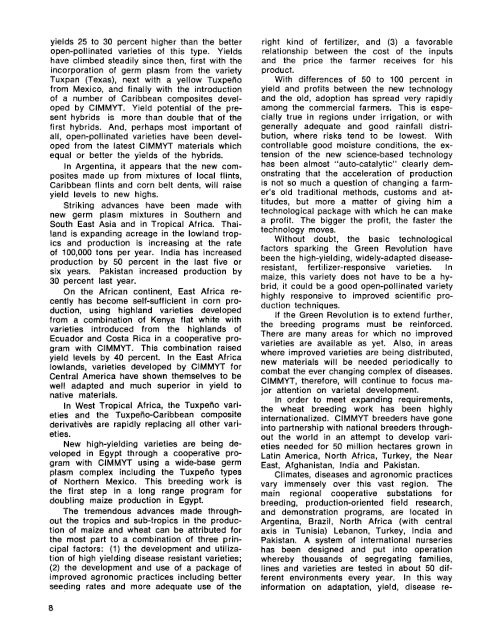REPORT - Search CIMMYT repository
REPORT - Search CIMMYT repository
REPORT - Search CIMMYT repository
Create successful ePaper yourself
Turn your PDF publications into a flip-book with our unique Google optimized e-Paper software.
yields 25 to 30 percent higher than the better<br />
open-pollinated varieties of this type. Yields<br />
have climbed steadily since then, first with the<br />
incorporation of germ plasm from the variety<br />
Tuxpan (Texas), next with a yellow Tuxpeiio<br />
from Mexico, and finally with the introduction<br />
of a number of Caribbean composites developed<br />
by <strong>CIMMYT</strong>. Yield potential of the present<br />
hybrids is more than double that of the<br />
first hybrids. And, perhaps most important of<br />
all, open-pollinated varieties have been developed<br />
from the latest <strong>CIMMYT</strong> materials which<br />
equal or better the yields of the hybrids.<br />
In Argentina, it appears that the new composites<br />
made up from mixtures of local flints,<br />
Caribbean flints and corn belt dents, will raise<br />
yield levels to new highs.<br />
Striking advances have been made with<br />
new germ plasm mixtures in Southern and<br />
South East Asia and in Tropical Africa. Thailand<br />
is expanding acreage in the lowland tropics<br />
and production is increasing at the rate<br />
of 100,000 tons per year. India has increased<br />
production by 50 percent in the last five or<br />
six years. Pakistan increased production by<br />
30 percent last year.<br />
On the African continent, East Africa recently<br />
has become self-sufficient in corn production,<br />
using highland varieties developed<br />
from a combination of Kenya flat white with<br />
varieties introduced from the highlands of<br />
Ecuador and Costa Rica in a cooperative program<br />
with <strong>CIMMYT</strong>. This combination raised<br />
yield levels by 40 percent. In the East Africa<br />
lowlands, varieties developed by <strong>CIMMYT</strong> for<br />
Central America have shown themselves to be<br />
well adapted and much superior in yield to<br />
native materials.<br />
In West Tropical Africa, the Tuxpeno varieties<br />
and the Tuxpeno-Caribbean composite<br />
derivatives are rapidly replacing all other varieties.<br />
New high-yielding varieties are being developed<br />
in Egypt through a cooperative program<br />
with <strong>CIMMYT</strong> using a wide-base germ<br />
plasm complex including the Tuxpeno types<br />
of Northern Mexico. This breeding work is<br />
the first step in a long range program for<br />
doubling maize production in Egypt.<br />
The tremendous advances made throughout<br />
the tropics and sub-tropics in the production<br />
of maize and wheat can be attributed for<br />
the most part to a combination of three principal<br />
factors: (1) the development and utilization<br />
of high yielding disease resistant varieties;<br />
(2) the development and use of a package of<br />
improved agronomic practices including better<br />
seeding rates and more adequate use of the<br />
right kind of fertilizer, and (3) a favorable<br />
relationship between the cost of the inputs<br />
and the price the farmer receives for his<br />
product.<br />
With differences of 50 to 100 percent in<br />
yield and profits between the new technology<br />
and the old, adoption has spread very rapidly<br />
among the commercial farmers. This is especially<br />
true in regions under irrigation, or with<br />
generally adequate and good rainfall distribution,<br />
where risks tend to be lowest. With<br />
controllable good moisture conditions, the extension<br />
of the new science-based technology<br />
has been almost "auto-catalytic" clearly demonstrating<br />
that the acceleration of production<br />
is not so much a question of changing a farmer's<br />
old traditional methods, customs and attitudes,<br />
but more a matter of giving him a<br />
technological package with which he can make<br />
a profit. The bigger the profit, the faster the<br />
technology moves.<br />
Without doubt, the basic technological<br />
factors sparking the Green Revolution have<br />
been the high-yielding, widely-adapted diseaseresistant,<br />
fertilizer-responsive varieties. In<br />
maize, this variety does not have to be a hybrid,<br />
it could be a good open-pollinated variety<br />
highly responsive to improved scientific production<br />
techniques.<br />
If the Green Revolution is to extend further,<br />
the breeding programs must be reinforced.<br />
There are many areas for which no improved<br />
varieties are available as yet. Also, in areas<br />
where improved varieties are being distributed,<br />
new materials will be needed periodically to<br />
combat the ever changing complex of diseases.<br />
<strong>CIMMYT</strong>, therefore, will continue to focus major<br />
attention on varietal development.<br />
In order to meet expanding requirements,<br />
the wheat breeding work has been highly<br />
internationalized. <strong>CIMMYT</strong> breeders have gone<br />
into partnership with national breeders throughout<br />
the world in an attempt to develop varieties<br />
needed for 50 million hectares grown in<br />
Latin America, North Africa, Turkey, the Near<br />
East, Afghanistan, India and Pakistan.<br />
Climates, diseases and agronomic practices<br />
vary immensely over this vast region. The<br />
main regional cooperative substations for<br />
breeding, production-oriented field research,<br />
and demonstration programs, are located in<br />
Argentina, Brazil, North Africa (with central<br />
axis in Tunisia) Lebanon, Turkey, India and<br />
Pakistan. A system of international nurseries<br />
has been designed and put into operation<br />
whereby thousands of segregating families,<br />
lines and varieties are tested in about 50 different<br />
environments every year. In this way<br />
information on adaptation, yield, disease re-<br />
8

















